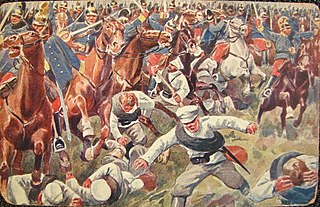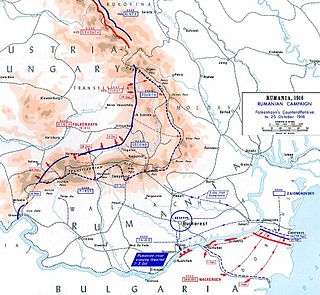
The Brusilov offensive, also known as the "June advance", of June to September 1916 was the Russian Empire's greatest feat of arms during World War I, and among the most lethal offensives in world history. The historian Graydon Tunstall called the Brusilov offensive the worst crisis of World War I for Austria-Hungary and the Triple Entente's greatest victory, but it came at a tremendous loss of life. The heavy casualties eliminated the offensive power of the Imperial Russian Army and contributed to Russia's revolution the next year.

The Battle of the Vistula River, also known as the Battle of Warsaw, was a Russian victory against the German Empire and Austria-Hungary on the Eastern Front during the First World War.

The Battle of Kraśnik started on August 23, 1914, in the province of Galicia and the adjacent areas across the border in the Russian Empire, in northern Austria, and ended two days later. The Austro-Hungarian First Army defeated the Russian Fourth Army. It was the first victory by Austria-Hungary in World War I. As a result, the First Army's commander, General Viktor Dankl, was (briefly) lauded as a national hero for his success. The battle was also the first of a series of engagements between Austria-Hungary and Russia all along the Galicia front.

The First Battle of the Masurian Lakes was a German offensive in the Eastern Front 2–16 September 1914, during the Russian invasion of East Prussia. It took place only days after the Battle of Tannenberg where the German Eighth Army encircled and destroyed the Russian Second Army. Using the rapid movements aided by the East Prussian railway network, the Eighth Army reformed in front of the spread-out Russian First Army and pushed them back across their entire front, eventually ejecting it from Germany. Further progress was hampered by the arrival of the Russian Tenth Army on the Germans' right flank.

The Gorlice–Tarnów offensive during World War I was initially conceived as a minor German offensive to relieve Russian pressure on the Austro-Hungarians to their south on the Eastern Front, but resulted in the Central Powers' chief offensive effort of 1915, causing the total collapse of the Russian lines and their retreat far into Russia. The continued series of actions lasted the majority of the campaigning season for 1915, starting in early May and only ending due to bad weather in October.

Aleksei Ermolaevich Evert was an Imperial Russian general of Orthodox German descent.

Georg Bruchmüller was a German artillery officer who greatly influenced the development of modern artillery tactics. He was nicknamed Durchbruchmüller, a combination of the German word Durchbruch (breakthrough) with his name.

The Great Retreat was a strategic withdrawal and evacuation on the Eastern Front of World War I in 1915. The Imperial Russian Army gave up the salient in Galicia and the Polish Congress Kingdom. The Russian Empire's critically under-equipped military suffered great losses in the Central Powers' July–September summer offensive operations, which led to the Stavka ordering a withdrawal to shorten the front lines and avoid the potential encirclement of large Russian forces in the salient. While the withdrawal itself was relatively well-conducted, it was a severe blow to Russian morale.

Alexander Frantsevich Ragoza, also known as Oleksandr Frantsevych Rohoza, was a Russian general of the infantry during World War I, and Minister of Defense of the Ukrainian State.

The 10th Army was a field army of the Imperial Russian Army during the First World War.

The Riga offensive, also called the Battle of Jugla or the Battle of Riga, took place in early September 1917 and was last major campaign on the Eastern Front of World War I before the Russian Provisional Government and its army began disintegrating.
The 8th Siberian Rifle Division was an infantry unit of the Imperial Russian Army. The division was formed in 1904 from a brigade, fighting in the Russo-Japanese War and World War I.
The 282nd Rifle Division was an infantry division of the Soviet Union's Red Army during World War II, formed twice.
Vladimir Vasilyevich Smirnov was an Imperial Russian Army general of the infantry who was a division, corps and field army commander. He fought in the Russian-Turkish War of 1877–1878 and in World War I.

The First Battle of the Jiu Valley was a military engagement during World War I fought between Romanian forces on one side and Central Powers forces on the other. The German offensive, although initially successful, was checked within days and subsequently repulsed by a Romanian counterattack. This was the most conspicuous Romanian victory during the 1916 campaign, given that it was achieved against forces which were superior in artillery and - initially - in numbers as well.

The Battle of Sălătrucu was a military engagement during the Romanian Campaign of World War I. It took place after the Battle of Transylvania and resulted in a Romanian victory. A mixed Central Powers force – under German leadership but with mostly Austro-Hungarian troops – conducted a failed offensive into Romanian territory, south of the Turnu Roșu Pass.

The Battle of the Southern Carpathians was a major operation during the Romanian Campaign of World War I. The brainchild of German General Erich von Falkenhayn, the operation consisted in an attempt by the Central Powers to assault all of the passes in the Southern Carpathians at the same time, and exploit a success wherever it might have come. However, this did not happen, as Romanian defenses could not be defeated in any of the five areas that Falkenhayn's spread-out army tried to force.

The 1917 Romanian Campaign consisted in three battles between late July and early September 1917, fought between Germany and Austria-Hungary on one side versus Romania and Russia on the other. Romania emerged from this campaign with a slight net territorial gain and won its most important battle during the First World War.
The 549th Volksgrenadier Division was a volksgrenadier infantry division of the German Army during World War II, active from 1944 to 1945. It was formed as the 549th Grenadier Division in July 1944 and became a volksgrenadier division several months later. Fighting on the Eastern Front, it was nearly destroyed in the East Prussian Offensive, with its remnants retreating west and surrendering to American troops at the end of the war.

The Battle of Nagyszeben was a World War I military engagement fought between the forces of the Central Powers on one side and the forces of Romania on the other side. It was the decisive engagement during the Battle of Transylvania, and also the largest, involving four armies out of the five fighting in the region: two Romanian, one German, and one Austro-Hungarian.
















